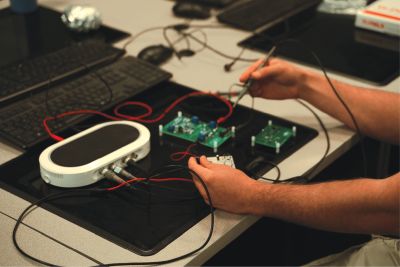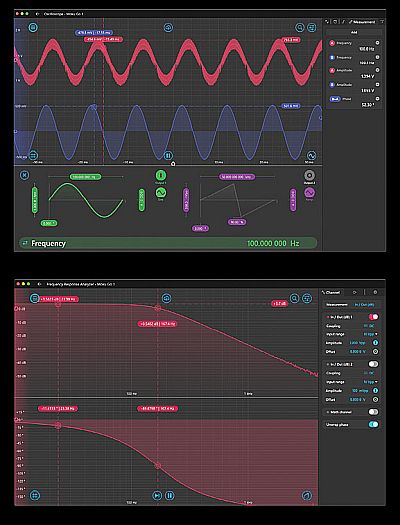Lab classes become much more meaningful when students can operate their own test instruments rather than watch an instructor turn knobs and push buttons.
Paul Cracknell, Liquid Instruments

The past couple years have taught many of us in engineering fields that we can indeed be productive working remotely. But ultimately, we often need in-person work and real hardware to get the job done. Ditto for teaching institutions. Even the best video conference cannot replace hands-on interaction and in-person lab classes.
In 2021, Liquid Instruments introduced Moku:Go as an integrated benchtop hardware platform, small enough to take home if needed. It integrates a suite of instruments that would be present on any undergraduate lab bench (an oscilloscope, waveform generator, programmable power supplies) as well as those that would typically be less accessible (spectrum analyzer, frequency response analyzer, lock-in amplifier, PID controller, and FIR and IIR filtering tools).
During the early days of the COVID-19 pandemic, we at Liquid Instruments were faced with a unique opportunity to help remote labs by using the multi-instrument Moku:Go. We saw that as much as students benefited greatly from being able to take a Moku:Go home and run experiments and lab exercises, this fell short of expectations of most engineering undergraduates from the perspective of interpersonal collaboration. As much as engineering is a practical discipline, it is a collaborative one as well; working with lab partners on a problem, discussing with fellow students, and having the presence of an experienced lab assistant ready to offer guidance cannot be as easily replicated remotely.
While virtual tutoring sessions and UI screen sharing were effective short-term solutions, Liquid Instruments was fortunate to host a number of COVID-19 safe student lab sessions, some outdoors in the fresh air, others with appropriate social distancing measures. These were held at several colleges including UCSD, Penn State, and the University of Arkansas. Accessing multiple instruments in a single, portable device enabled enhanced flexibility in a world that required it.

Decisions about the best test and measurement equipment for the classroom must now consider usability and learnability, as these can greatly enhance the students’ experience and confidence. An overly complex UI can be intimidating and detracts significantly from subject matter learning. Teaching assistants at the undergraduate level consistently report that up to half of their valuable lab time goes toward troubleshooting test equipment issues. The primary focus should be on effectively teaching the technical subject at hand and not trying to get the equipment to work, which is frustrating for the department and student alike.

Power supplies are a key element of any lab bench. Integrating them into Moku:Go alleviates the need for a separate bench supply. The student can then focus on using the probes of the oscilloscope and connections of the swept sine waveform generator.
To give students a sense for the impact of the filter, the lab exercise starts with students stepping the waveform generator through a frequency range and taking manual, step-by-step measurements of the output amplitude and phase across frequency. This real hands-on lab experience enables students to visualize the signals and explore various operating points.
After manually plotting perhaps a half dozen points, students can naturally progress to using the integrated Frequency Response Analyzer (FRA) instrument to rapidly/automatically plot the Bode chart. With this sequence, analog, op-amp based filters can be covered in two or three labs so students can move to the digital or DSP-based filter solutions which now dominate modern designs.
Bridging simulation and implementation
Simulation is critical for electrical engineering design, but transitioning to a real hardware implementation is the ultimate goal. It’s crucial to help students understand how to make that transition and correlate results between simulation and physical measurements. MATLAB can help relate the mathematical foundation of filters to real-world responses. For example, students can use MATLAB filter designer to design a specific filter response.
When the MATLAB simulation has produced a desired response, the filter coefficients can then be exported and uploaded to Moku:Go’s digital filter tools to realize the filter in hardware. Once the filter is running on real hardware, an oscilloscope and waveform generator, or FRA can then be used to confirm the frequency response. This ‘closes the loop’ on the design process and gives students a complete view of a design cycle. Together with a modern UI on a multi-functional instrument, this makes for an enjoyable and rewarding student experience while focusing attention on the subject matter rather than on the tools themselves.
Proportional-integral-derivative (PID) controllers find use in numerous engineering settings. No wonder, then, that their mathematical and theoretical underpinnings are extensively covered in textbooks and classroom lectures. But a solid lab tutorial is invaluable for grasping the use of PID controllers to the real world. That’s why we designed a PID controller instrument for Moku:Go. This capability allows a lab to be readily written around the PID controller where students can adjust parameters in real-time and see the impact on the loop response.
Our focus has been primarily on ensuring Moku:Go addresses the needs and learning expectations of undergraduate. But it is also important to consider budget constraints and logistics of educational institutions. A typical undergraduate lab might be budgeted for a number of stations containing power supplies, oscilloscopes and waveform generators. If the lab contains a spectrum analyzer, PID controller or Lock-in Amplifier, there’s generally only one or two; so only larger groups can use them.

Moku:Go also aims at a higher goal of equalization of learning outcomes. It is well-known that students learn at different paces. So it can be challenging to get a whole class on equal footing at the end of each school year. This is doubly true in engineering where lab time is limited. Portability and integration in hardware make things easier for students who need extra time. We want every student to graduate as the best engineer they can be, and that means providing them with as much hands-on experience in the lab as possible.
We learned a lot about engineering and science education during the COVID-19 pandemic. While remote, video conferencing works to a certain extent for lectures, it is a poor substitute for in-person, hands-on laboratory learning. Engineering is by its nature theoretical and mathematical, but ultimately practical. Every graduate engineer must translate theoretical knowledge into real-world practice and solutions for society.
Practical lab experience is critical in providing solutions to real world problems. Today’s undergraduates have high expectations of user interface for the devices they use in their everyday life. The next generation expects their test and measurement equipment to live up to these standards – standards that allow them to do their best work.
References






Leave a Reply
You must be logged in to post a comment.